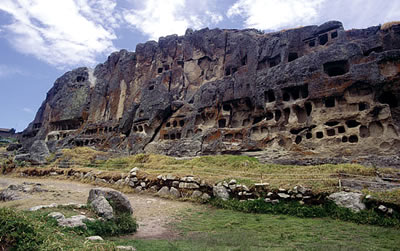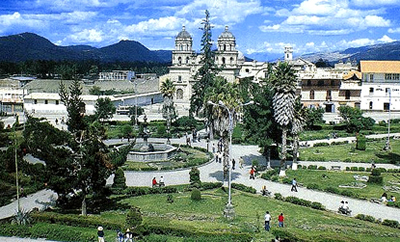World History
Site of one of the most memorable and important set of events in the Spanish conquest of the Americas, the valley and town of Cajamarca sit high in the northern Andes Mountains. It was here, on Friday, November 15, 1532, that Francisco Pizarro’s 62 horsemen and 106 foot soldiers had the striking good fortune to encounter the large military force of the Inca Atahualpa.
The next day, after an initial exchange of pleasantries, the greatly outnumbered Spanish force launched a surprise attack from behind a series of walled enclosures, slaughtering an estimated 6,000 of the Inca’s soldiers before taking the Inca himself hostage. The Inca soldiers, wielding slings and clubs, proved no match for the armored Spanish horsemen and their steel swords and pikes.
After witnessing the deaths of thousands of his troops, the captive Inca offered the bearded strangers an enormous ransom of gold, silver, and precious objects to secure his release—enough to fill a room measuring approximately 85 cubic meters: the famous Atahualpa’s ransom.
For the next seven months, trains of porters carted to Cajamarca precious objects from across the Inca realm. During this period, the Spanish had ample opportunity to observe the Inca and take careful note of his and his followers’ customs and rituals. Regarded as a semidivine being, the Inca had his every need attended to by large numbers of servants and retainers.
In mid-February 1533, as the treasure slowly trickled into Cajamarca and his men grew increasingly restless, Pizarro sent a large reconnaissance expedition, led by his brother Hernando, south to survey the route to the Inca capital in Cuzco. In mid-April 1533, the 153-strong contingent of Diego de Almagro marched into Cajamarca from the Pacific coast, effectively doubling the Spanish force.
Not having participated in the slaughter in the square or capture of Atahualpa, Almagro and his men were to receive a substantially lesser share of the ransom, sowing the seeds of the Almagrist civil wars that wracked the early years of the conquest of Peru.
Eleven days later, on April 25, after some three months, the reconnaissance expedition of Hernando Pizarro returned to Cajamarca with important intelligence on the topography that lay between Cajamarca and Cuzco and the distribution of the Inca’s military strength.
The melting down of the accumulated treasure began on March 16, 1533, and continued for nearly four months, until July 9. Distribution of the loot commenced on July 16.
An estimated 110,000 kilograms of gold objects were melted down in the furnaces of Cajamarca, transformed from vessels, ornaments, and other artistic objects into bars of bullion. Each Spanish soldier received an allotment based on his rank, status, and degree of participation in the events of November 15–16, 1532, with Almagro’s men receiving a far lesser share than Pizarro’s.
Finally, on July 26, 1533, some 10 days after the distribution of the loot began, Pizarro decided not to honor the agreement to release Atahualpa but instead to execute him. All of these events mark Cajamarca as the site of one of the most dramatic and important episodes in the history of the European conquest of the New World.
- Diego De Almagro
Diego de AlmagroA leading figure in the conquest of Peru Diego de Almagro launched a rebellion against the Pizarro brothers around Cuzco that convulsed the newly conquered Andean territories in civil war (1537–38) and led to his own death by garroting...
- Conquest Of Peru
Conquest of Peru Following on the heels of the Spanish conquest of the Caribbean, conquest of Mexico, and conquest of Central America, the conquest of Peru was a long, complex, and bloody process marked by recurrent civil wars among factions of Spaniards...
- Francisco Pizarro
Francisco PizarroRanking with Hernán Cortés as one of the most ruthless and effective of all the Spanish conquistadores, Francisco Pizarro was the principal force behind the conquest of Peru and subjugation of the Inca Empire in the 1530s. Along...
- Machu Picchu: How They Kept The Secret
Machu Picchu: How They Kept the Secret. This site features an Incan expert who explores the riddle of how the center of Inca culture was hidden from Spanish conquistadores. Wikipedia notes that Machu Pichu is a "well-preserved pre-Columbian Inca ruin...
- History Of Peru
History of Peru. This is brief but well written overview to the history of the South American nation of Peru. From the site: When the Spanish landed in 1531, Peru's territory was the nucleus of the highly developed Inca civilization. Centered...
World History
Cajamarca, Peru
 |
| ruin in cajamarca |
Site of one of the most memorable and important set of events in the Spanish conquest of the Americas, the valley and town of Cajamarca sit high in the northern Andes Mountains. It was here, on Friday, November 15, 1532, that Francisco Pizarro’s 62 horsemen and 106 foot soldiers had the striking good fortune to encounter the large military force of the Inca Atahualpa.
The next day, after an initial exchange of pleasantries, the greatly outnumbered Spanish force launched a surprise attack from behind a series of walled enclosures, slaughtering an estimated 6,000 of the Inca’s soldiers before taking the Inca himself hostage. The Inca soldiers, wielding slings and clubs, proved no match for the armored Spanish horsemen and their steel swords and pikes.
After witnessing the deaths of thousands of his troops, the captive Inca offered the bearded strangers an enormous ransom of gold, silver, and precious objects to secure his release—enough to fill a room measuring approximately 85 cubic meters: the famous Atahualpa’s ransom.
  |   |
For the next seven months, trains of porters carted to Cajamarca precious objects from across the Inca realm. During this period, the Spanish had ample opportunity to observe the Inca and take careful note of his and his followers’ customs and rituals. Regarded as a semidivine being, the Inca had his every need attended to by large numbers of servants and retainers.
In mid-February 1533, as the treasure slowly trickled into Cajamarca and his men grew increasingly restless, Pizarro sent a large reconnaissance expedition, led by his brother Hernando, south to survey the route to the Inca capital in Cuzco. In mid-April 1533, the 153-strong contingent of Diego de Almagro marched into Cajamarca from the Pacific coast, effectively doubling the Spanish force.
Not having participated in the slaughter in the square or capture of Atahualpa, Almagro and his men were to receive a substantially lesser share of the ransom, sowing the seeds of the Almagrist civil wars that wracked the early years of the conquest of Peru.
 |
| Cajamarca today |
Eleven days later, on April 25, after some three months, the reconnaissance expedition of Hernando Pizarro returned to Cajamarca with important intelligence on the topography that lay between Cajamarca and Cuzco and the distribution of the Inca’s military strength.
The melting down of the accumulated treasure began on March 16, 1533, and continued for nearly four months, until July 9. Distribution of the loot commenced on July 16.
An estimated 110,000 kilograms of gold objects were melted down in the furnaces of Cajamarca, transformed from vessels, ornaments, and other artistic objects into bars of bullion. Each Spanish soldier received an allotment based on his rank, status, and degree of participation in the events of November 15–16, 1532, with Almagro’s men receiving a far lesser share than Pizarro’s.
Finally, on July 26, 1533, some 10 days after the distribution of the loot began, Pizarro decided not to honor the agreement to release Atahualpa but instead to execute him. All of these events mark Cajamarca as the site of one of the most dramatic and important episodes in the history of the European conquest of the New World.
- Diego De Almagro
Diego de AlmagroA leading figure in the conquest of Peru Diego de Almagro launched a rebellion against the Pizarro brothers around Cuzco that convulsed the newly conquered Andean territories in civil war (1537–38) and led to his own death by garroting...
- Conquest Of Peru
Conquest of Peru Following on the heels of the Spanish conquest of the Caribbean, conquest of Mexico, and conquest of Central America, the conquest of Peru was a long, complex, and bloody process marked by recurrent civil wars among factions of Spaniards...
- Francisco Pizarro
Francisco PizarroRanking with Hernán Cortés as one of the most ruthless and effective of all the Spanish conquistadores, Francisco Pizarro was the principal force behind the conquest of Peru and subjugation of the Inca Empire in the 1530s. Along...
- Machu Picchu: How They Kept The Secret
Machu Picchu: How They Kept the Secret. This site features an Incan expert who explores the riddle of how the center of Inca culture was hidden from Spanish conquistadores. Wikipedia notes that Machu Pichu is a "well-preserved pre-Columbian Inca ruin...
- History Of Peru
History of Peru. This is brief but well written overview to the history of the South American nation of Peru. From the site: When the Spanish landed in 1531, Peru's territory was the nucleus of the highly developed Inca civilization. Centered...
